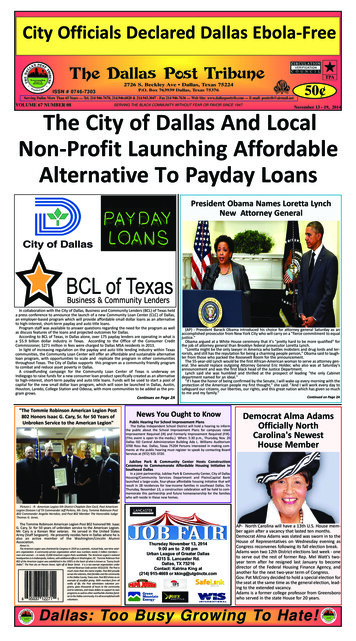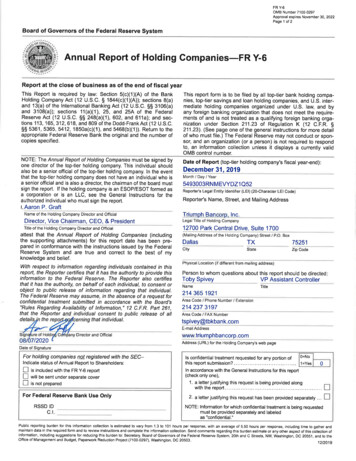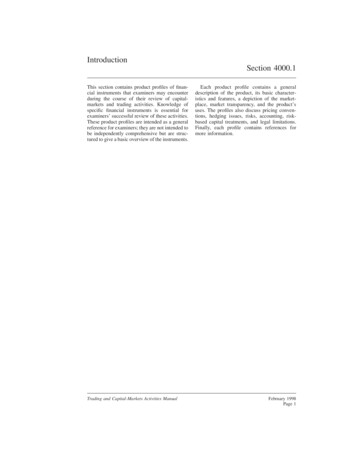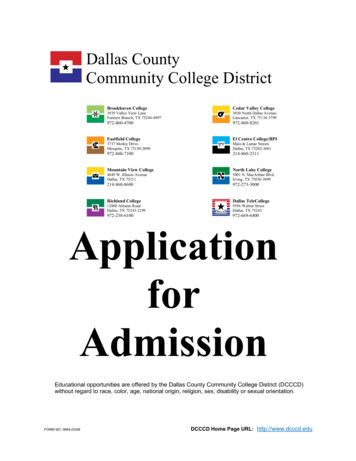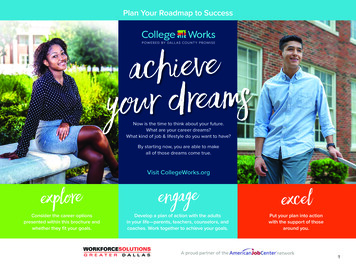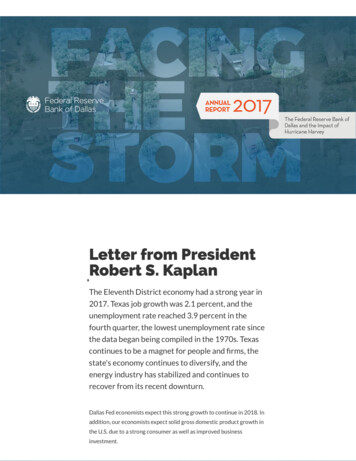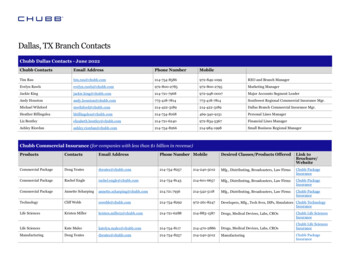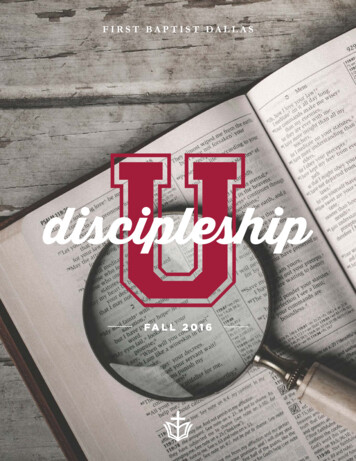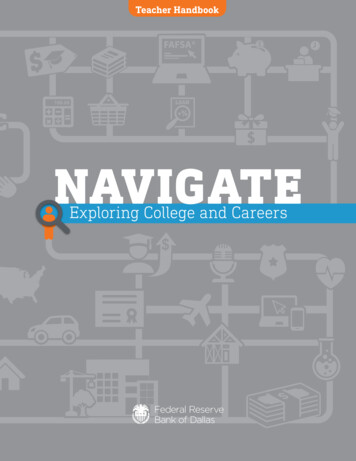
Transcription
Teacher HandbookNAVIGATEExploring College and CareersFederal ReserveBank of Dallas
NAVIGATE: Exploring College and Careersis produced by the Economic Education division, Communications &Outreach Department, Federal Reserve Bank of Dallas.The Federal Reserve Bank of Dallas is part of the Federal ReserveSystem, the central bank of the United States. The Dallas Fed hasbranch offices in El Paso, Houston and San Antonio.Economic Education ContactsSusan Kizersusan.kizer@dal.frb.orgAuthorsPrinceton Williams, DallasLupe Mares, El PasoSusan Kizer, HoustonGraphic Designer and IllustratorSamantha CoplenDallas Fed Economic Educationmaterials are available atwww.dallasfed.org/educate.EditorJennifer AfflerbachNAVIGATE: Exploring College and Careers was inspired by Let's TalkAbout College, a program developed by the Federal Reserve Bank of Bostonand the Citizens School.www.dallasfed.org/educate
Teacher HandbookNAVIGATEExploring College and CareersUnit 1 Exploring Careers2Unit 2 What About College?9Unit 3 How Do I Get In?14Unit 4 How Much Does College Cost? 22Unit 5 Paying for College26Unit 6 Future Paths37NAVIGATE: Exploring College and Careers1Federal Reserve Bank of Dallas
Unit 1 Exploring CareersUnit 1Exploring CareersThe idea that education affects earning potential seems straightforward, but thedata tell a powerful story. Workers with more education have a higher median salaryand a lower unemployment rate. Economists attribute this to the role of educationin developing human capital—a person’s knowledge, talent, experience and skills.People invest in their human capital by going to school, pursuing additional trainingand acquiring skills. Because workers who develop their human capital increase theirproductivity, they are generally paid more.To learn about the education and skills related to a particular job, a student can usethe Occupational Outlook Handbook, produced by the U.S. Bureau of Labor Statistics.The handbook, an online guide to hundreds of careers, describes the median payand working conditions of the jobs. It also includes the typical education required atthe entry level, along with projections for the growth of the occupation over the nextdecade. The Occupational Outlook Handbook can be found at www.bls.gov/ooh/.Lesson OverviewTo demonstrate the connection between skill development and productivity, students will create a nametent for their desks. Different groups of students will produce the name tent in different ways, such asusing their nondominant hand. The students will debrief the activity by discussing how training and skilldevelopment affect productivity. Then, the class will brainstorm reasons to further their education afterhigh school. Students will individually use information from the Bureau of Labor Statistics’ OccupationalOutlook Handbook to research a career. They will describe the career, its work environment, requirededucation/experience and pay/job outlook.Instructional Objectives Describe the relationship between education and the development of human capital. Describe the required education, the earning potential and the working conditions for a career. Compare the earning potential of workers who have different levels of educational attainment.Time Required90 minutesFederal Reserve Bank of Dallas2200 N. Pearl StreetDallas, TX 75201-2216214-922-5270800-333-4460, ext. 5270dal.econed@dal.frb.orgNAVIGATE: Exploring College and Careers2Federal Reserve Bank of Dallas
Unit 1 Exploring CareersMaterials RequiredFor each student Student Workbook One sheet of light-colored construction paper MarkerFor the classroom Computer lab access (or printed copies of occupation profiles—see step 10) Classroom computer with Internet access and projector One sheet of light-colored construction paper for demonstrationProcedure1. Tell students that they will create name tents for display on their desks for the day.2. Demonstrate how to produce a name tent using a sheet of construction paper. Tell the students towatch but not to start their name tent. Fold the piece of construction paper in half by placing the shorter edges (8”) together. Crease the center fold. The folded paper should measure 8” x 5.5”. Open the paper to 8” x 11”. Fold the bottom 8” edge to the middle crease. Crease the fold. Open the paper to 8” x 11”. Fold the top 8” edge to the middle crease. Crease the fold. The paper should now have four sections, each measuring approximately 2.75” x 8”. With the folds facing you, count down three rectangles from the top of the paper. Print your firstname in large letters in the rectangle. Turn the paper upside down. Again count down three rectangles and print your first name in largeletters in the rectangle. Fold the paper to create a tent with the name displayed on both sides.NAVIGATE: Exploring College and Careers3Federal Reserve Bank of Dallas
Unit 1 Exploring Careers3. Tell students that each of them will produce a name tent, but there will be different rules. Divide thestudents into four groups and describe the rules for each group as follows. Tell them to wait to starttheir name tent. Group 1 will remain seated to produce the name tents. They may use both hands. Group 2 will remain seated to produce the name tent, but they must keep their dominant hand—thehand with which they write—behind their back. They can only use their nondominant hand—thehand with which they do not write—to produce the name tent. Group 3 will remain seated to produce the name tent, but they must keep their nondominanthand—the hand with which they do not write—behind their back. They can only use their dominanthand—the hand with which you do write—to produce the name tent. Group 4 will produce the name tent while standing up and using only the nondominant hand toproduce the name tent. They must keep their dominant hand behind their back. They may not usethe desk, table, chair or floor. They may not work with another student.4. Distribute a piece of construction paper and a marker to each student. Remind students that eachgroup must fold name tents according to the rules described. Students should raise their handsindividually when they have finished their name tents. Tell students to begin.5. After most students have finished, ask everyone to stop producing name tents and discuss thefollowing questions. Did any students find it very difficult to produce name tents? Why?Students in Groups 2 and 4 had the most difficulty. They found that using their nondominant handwas challenging. Standing and folding with the nondominant hand made it nearly impossible. In general, which group finished most quickly? Why?Group 1 was able to use both hands and was able to remain seated and use the table. In general, which group of students took the longest time to finish? Why?Group 4 took the longest and had the name tents that were the hardest to read. Students in thisgroup had to use only the nondominant hand and stand. They also did not get to use tools, such asthe desk or floor. What makes using your dominant hand so much easier?Students have been practicing writing since they were very young. They have been trained to writewith their dominant hand. Did using the table make a difference?Without tools and equipment, such as the desk or floor, the task was more challenging.6. Introduce the idea of human capital to the students. Use the following information to guidethe discussion. Human capital is the knowledge, talent, experience and skills that people possess. People are able to invest in their human capital by going to school, pursuing additional training anddeveloping skills. Workers who develop their human capital are more productive. Productivity is also increased by using tools and equipment.NAVIGATE: Exploring College and Careers4Federal Reserve Bank of Dallas
Unit 1 Exploring CareersRemind students that Group 1—the group that used their dominant hand and the table—producedthe name tents faster and at a higher quality than the other groups. They were more productive.Explain that people with more skills, education and training tend to be more productive and, as aresult, earn higher incomes.7. Have students work with a partner to define “human capital” in their own words. Write the definitionon page 4 in the Student Workbook. Ask some students to share their definition with the class.8. Tell students to work with a partner to brainstorm five skills or talents that each one currentlypossesses. Write them in the appropriate space on page 4. Encourage students to think aboutinterests and talents broadly, including school subjects that they like, hobbies, extracurricularactivities, etc. After they identify these skills or talents, ask them to think about ways they coulddevelop these skills and talents through education, training and experiences. Write the ideas on thesame page in the box labeled “The Road Ahead.”9. Tell students that one very important reason to continue their education after high school is todevelop skills, increase their human capital and potentially increase their lifetime earnings.10. Allow students to select a career to research from the list on pages 5–6 of the Student Workbook.Tell students that these are careers that have been studied by the United States Bureau of LaborStatistics. Display the “Occupational Outlook Handbook” page at www.bls.gov/ooh and demonstratehow to find a career listing.Visit http://www.bls.gov/ooh/about/teachers-guide.htm to find a teacher’s guide to the website.Also, the website provides a printer-friendly option for every profession. If access to a computer labis limited, the teacher could print enough different occupational information packets for students tocomplete research.NAVIGATE: Exploring College and Careers5Federal Reserve Bank of Dallas
Unit 1 Exploring Careers11. Have students open the Student Workbook to page 7. Review the sections of the website thatstudents will use to research the career that they selected. The What They Do tab contains information about the duties associated with the job and mightcontain information about specializations within the field. Students should use this information tocomplete “Explain what you do.” The Work Environment tab contains details about the typical workplace, schedule and hazardsrelated to the career. Students should use this information to complete “Describe where you work.” The How to Become One tab contains information about required training, education and licenses.The BLS uses the following categories to describe educational requirements. They are defined inthe glossary in the Student Workbook. Students should use this information to complete “Howmuch education will you need?” Less than high school High school diploma or equivalent (such as a GED) Some college, no degree Postsecondary non-degree award Associate degree Bachelor’s degree Master’s degree Doctoral or professional degree The Pay tab contains the median wage for the career, along with comparisons to similar jobs and alloccupations. Students should use this information to complete “How much will you earn?” Remind students that half of all workers in the career earn more than the median wage andhalf earn less. Students should compute median weekly wage by dividing the annual pay by 52. If only an hourly wage is given, multiply the wage by 40 hours to find weekly wage. Then multiply the weekly wage by 52 to find the annual wage.12. Tell students to research information about the career they selected and record the information onpage 7 of the Student Workbook.13. Display the graph of earnings by educational attainment that can be found at www.bls.gov/emp/ep chart 001.htm. (Note: See the screen shot on the next page. To search for the graph, visitwww.bls.gov and search for “income by educational attainment.”) Use the graph and the informationbelow to discuss the link between higher educational attainment and average earnings. This graph compares the median weekly earnings of full-time workers, over age 25, with variouslevels of education. In general, workers with higher levels of educational attainment havehigher wages. The chart also displays the unemployment rate by level of educational attainment. It shows thatpeople with higher levels of educational attainment generally have a lower level of unemployment.Have students transfer the data on median weekly earnings from the chart to page 8 in the StudentWorkbook and answer the questions.NAVIGATE: Exploring College and Careers6Federal Reserve Bank of Dallas
Unit 1 Exploring CareersClosure14. Have students divide into groups based on the education required for an entry-level job in the careerthey researched. Within the groups, have students compare median salaries. Discuss the range ofsalaries within each level of educational attainment, using the information below: Salaries within each level of educational attainment will vary based on market conditions, includingthe number of jobs available, growth or decline in the field and the number of qualified candidatesfor the jobs. The nature of the job, including work environment, hazards and location, can also affect mediansalary. Consumer demand for the good or service produced by the worker affects the earnings.Assessment15. Assess student research, using the rubric found on page 8.Extension ActivityHave students visit www.mynextmove.org. Selecting the “I’m not really sure” icon allows thestudent to complete an interest survey to identify potential careers that match the student’spreferences.The name tent activity was originally developed by the Federal Reserve Bank of St. Louis and published in It’s Your Paycheck, Lesson 1:Invest in Yourself.NAVIGATE: Exploring College and Careers7Federal Reserve Bank of Dallas
Unit 1 Exploring CareersAssessment RubricStudent Name1. Did the student identify a career?40Career identifiedNo responsePoints2. Did the student provide clear and complete information about the job description?43Clear and completeinformationSome flawsin clarity orcompleteness210Flaws in clarity andcompletenessSignificant flawsin clarity andcompletenessNo responsePoints3. Did the student provide clear and complete information about the work environment?43210Clear and completeinformationSome flawsin clarity orcompletenessFlaws in clarity andcompletenessSignificant flawsin clarity andcompletenessNo responsePoints4. Did the student identify the educational requirement?40Education levelindicatedNo responsePoints5. Did the student correctly compute weekly wage using annual wage?420PointsCorrectlycomputedMistakes incomputationNo response6. Did the student complete the graph and answer the questions on page 8?43210Clear and completeinformationSome flawsin clarity orcompletenessFlaws in clarity andcompletenessSignificant flawsin clarity andcompletenessNo responsePointsTotal Points(24 points possible)NAVIGATE: Exploring College and Careers8Federal Reserve Bank of Dallas
Unit 2What About College?Education after high school is critical as workers develop skills that will enhance theiremployment opportunities. Post-secondary education can be found at technicalinstitutions, two-year (community or junior) colleges and four-year colleges anduniversities. In Navigate, these institutions are broadly referred to as “colleges.” Avariety of traits and characteristics differentiate these colleges, including geographicsetting, school size, course offerings, costs, student population and campus life.Information about a variety of colleges can be found on a College Board websitecalled Big Future (bigfuture.collegeboard.org). The information is self-reported by theschools to the College Board. The website’s standardized reporting format and easysearch feature facilitate comparisons, and every college profile contains a link to theinstitution’s website, where more in-depth information can be found.Lesson OverviewStudents will learn basic terms used to describe colleges and will conduct research on different typesof institutions. Research findings will be presented on posters, and students will participate in a gallerywalk to analyze common characteristics of different colleges.Instructional Objectives Use relevant terms when describing colleges. Compare the educational programs and related costs at various institutions. Use technology to find information about colleges.Time Required 45 minutes for website overview and research In-class or out-of-class time to create poster 30–45 minutes for gallery walk and closureMaterials RequiredFor each student Student WorkbookFederal Reserve Bank of Dallas Large paper or poster2200 boardsN. Pearl StreetDallas, TX 75201-2216 Markers214-922-5270For the classroom800-333-4460, ext. 5270 Computer lab accessdal.econed@dal.frb.org Classroom computer with Internet access and projectorNAVIGATE: Exploring College and Careers9Federal Reserve Bank of Dallas
Unit 2 What About College?Procedure1. Remind students that in Unit 1: Exploring Careers, they researched various careers and identified theeducation required. This unit is about the types of schools where students can pursue education afterthey graduate from high school.2. Tell students that they will be conducting research about a college. Have students turn to page 10 inthe Student Workbook. Discuss each term and tell students that these are important words that willhelp them analyze college options. My SchoolThe official name of the institution Two-year or four-yearTwo-year schools offer associate degrees and workforce certification programs and are sometimescalled junior or community colleges. Four-year schools offer bachelor’s degrees, as well as graduatedegrees in many cases. Public or privatePublic schools are colleges or universities that are administered by a local or state government andreceive funding from government sources. Private schools are administered by a private organizationand receive the majority of their funding from tuition, fees and donations to the school. Six-year graduation rate (only four-year schools)Most bachelor degrees are designed to be completed in four years of full-time studies. Since manystudents take more than four years to complete a bachelor’s degree, the website offers a statisticthat shows the percentage of students who complete a bachelor’s degree within six years ofenrollment. LocationThe city where the campus is located Commuter or residentialA commuter school has a majority of students who live off-campus and travel to the school forcourses and other activities. A residential school has a majority of students who live on-campus indorms or other housing. Team name (mascot)Most schools have a mascot or a team name. Tuition and fees (in-state)An indicator of the cost of attending the school (Students will learn more about costs in Unit 4.) Number of undergraduatesThe total size of the institution Ethnic diversityThe relative size of different ethnic groups enrolled at the school Gender ratioA comparison of the number of males and females enrolled at the school Student-faculty ratioThe number of students per faculty member can be an indication of the average size of a class.Classes might be much larger or smaller than this ratio.NAVIGATE: Exploring College and Careers10Federal Reserve Bank of Dallas
Unit 2 What About College?3. Display bigfuture.collegeboard.org. Demonstrate the website by entering the name of a college oruniversity in the search bar and selecting the institution from the search results.Note: Select a school that is familiar to students or choose the school that the teacher attended.On the school profile, point out the tabs on the left side. Tell students that the information about theschool that they will be researching can be found in one of these sections. At a Glance (name of school, private or public, two-year or four-year, location, six-yeargraduation rate) Deadlines (not used in this research project) Majors and Learning Environment (student-faculty ratio) Campus Life (number of undergraduates, gender ratio, ethnic diversity, commuter vs. residential) Applying (not used in this research project) Paying (in-state tuition and fees)4. Allow students to select a college to research or assign a school to each student. Tell students towrite the information that they find for each category on page 10 in the Student Workbook.Note: It is helpful if students select a variety of types of institutions, including private and public, twoyear and four-year. If students have difficulty identifying colleges, the teacher could produce a list ofschools and allow students to pick from the list. The search feature on the website allows the user toproduce a list of all colleges in one or more states.5. Have students produce a poster to communicate information about the school they selected.6. Display posters in three groups—private four-year schools, public four-year schools and two-yearschools.7. Group students in teams of two to four. Have groups conduct a gallery walk and compare theinformation about the various types of colleges. Have students record common characteristics ofeach type of college on the chart on page 11 of the Student Workbook.Closure8. Discuss student observations using the information below and student notes. Students should usethe space on page 12 in the Student Workbook to take notes during the discussion.9. Discuss the common characteristics of private four-year colleges discovered during the gallerywalk. Have students brainstorm advantages and disadvantages to this type of school. Answers mightinclude, but are not limited to: Higher graduation rates Smaller student-faculty ratio Tuition and fees are higherNAVIGATE: Exploring College and Careers11Federal Reserve Bank of Dallas
Unit 2 What About College?10. Discuss the common characteristics of public four-year colleges discovered during the gallery walk.Have students brainstorm advantages and disadvantages to this type of school. Answers mightinclude, but are not limited to: Larger campuses Lower tuition and fees More commuter students11. Discuss the common characteristics of community colleges discovered during the gallery walk. Havestudents brainstorm advantages and disadvantages to this type of school. Answers might include,but are not limited to: Much lower tuition and fees Flexible schedules Usually commuter campuses Offer workforce certifications, such as technical studies, medicine and cosmetologyAssessment12. Assess student-created poster for accurate representation of data and neatness of student work. Usethe rubric on page 13.Extension ActivityHave students create a PowerPoint using information from research for presentation or electronicdistribution.NAVIGATE: Exploring College and Careers12Federal Reserve Bank of Dallas
Unit 2 What About College?Assessment RubricStudent NameIncludedNot IncludedMy SchoolTwo-year or four-yearPublic or privateSix-year graduation rate (only four-year schools)LocationCommuter or residentialTeam name (mascot)Tuition and fees (in-state)Ethnic diversityNumber of undergraduatesGender ratioStudent-faculty ratioOverall Presentation (including neatness and creativity)NAVIGATE: Exploring College and Careers1312345Federal Reserve Bank of Dallas
Unit 3How Do I Get In?Admission to college can be competitive. If students create a plan to maximize theirhigh school years, they increase their options for education beyond high school. Thereis no single path to college admission, but a well-thought-out plan will help studentsensure that they have used their high school opportunities to maximum benefit.The vocabulary of the college application process can be daunting. Students encounterthe idea of GPA and transcripts, along with national standardized tests such as SAT andACT. Extracurricular activities, both in and out of school, provide valuable learning andservice opportunities for students. However, students need to remember to track theiractivities and awards in preparation for applying for both financial aid and admission.States and local school districts set requirements for high school graduation, but manycolleges require course work beyond basic requirements. These requirements canchange from year to year. School counselors are a vital source of information aboutcurrent graduation requirements.Lesson OverviewStudents will complete a graphic organizer during an interactive presentation about the factors that colleges consider during the admission process. Following the presentation, students will outline individualaction items that will improve the likelihood of success in the college process. Instructors can extend thelesson by assigning students an admission essay.Instructional Objectives Identify key factors that colleges consider in the admission process. Create individual action plan to optimize future choices and success. Define relevant terms used in the college application.Time Required90 minutesMaterials RequiredFor each student Federal Reserve Bank of Dallas Student Workbook2200 N. Pearl StreetDallas, TX 75201-2216For the classroom214-922-5270 Unit 3 slides (availableat t. 5270 Classroom computerwith Internet access and projectordal.econed@dal.frb.orgNAVIGATE: Exploring College and Careers14Federal Reserve Bank of Dallas
Unit 3 How Do I Get In?Procedure1. Display Slide 1. Tell students that many high school students eagerly anticipate the day that anacceptance letter arrives from their college or university. There are many factors that will contributeto the student receiving an acceptance letter.2. Display Slide 2. Introduce the items that colleges consider during the application process. Tellstudents to open the Student Workbook to pages 14–15 and take notes on each of these blanksduring the lesson.3. Display Slide 3. Use the visual on the slide and the information below to discuss the importance ofcourse selection to the college admission process. High school courses need to be varied. Most schools require a minimum of these core courses forgraduation. Electives help students demonstrate a variety of interests. Core classes (English, math, social studies, science) Academic electives (Foreign languages, journalism, debate, college exploration/readiness, etc.) Arts (Band, choir, theater, art, etc.) Athletics Career and technology High school courses need to be challenging. Take the most advanced classes that you can.Tell students that counselors and academic advisors can help them select classes that align withtheir academic goals. It is important for students to get to know these individuals. Summarize byasking students why varied courses and challenging courses could be important. Answers will vary,but might include the following: to demonstrate the breadth of interests and ability; to provide exploration for possible careers; to meet requirements for graduation and college admission.Have students make a note under “Courses” that the courses they take should be varied andchallenging.4. Display Slide 4. Tell students to turn to the glossary in the Student Workbook. Select a studentto read the definition of these four terms out loud. Discuss how these types of classes can be animportant way to prepare students for college-level work, as well as earn college credit. Advanced Placement, or AP, courses Dual-credit courses International Baccalaureate (IB) Program courses Credit-by-examStudents can select advanced courses based on past performance, testing results and other factors.Tell students that they should talk to their counselor about advanced courses that are available.5. Display Slide 5. Tell students that all of their high school grades will be recorded on their officialschool transcript. This transcript will contain the final grade from every high school class they take.Use the following definitions to discuss these terms with the students.NAVIGATE: Exploring College and Careers15Federal Reserve Bank of Dallas
Unit 3 How Do I Get In? Transcript—an official record of a student’s gradesTranscripts are maintained by the school and are usually sent to colleges directly by the school. Grade point average (GPA)—a number that represents a student’s average grade in all classesSome schools calculate the GPA using a numeric grade from each class that ranges from zero to 100.Other schools assign points to letter grades earned (4 for “A,” 3 for “B,” etc.). In this system, the GPAranges from 0 to 4. (Teacher note: If possible, find out the system for GPA calculations used in yourschool district.) Weighted GPA—a GPA that is calculated with extra points added to the grade value for honors oradvanced coursesMany schools add points to the final grade of an honors or advanced course, so a grade of 94 mightbe included in the weighted GPA as a 104. In schools with a zero to 4 scale, an A in these coursesmight receive 5 points (rather than 4), a B would receive 4 points (rather than 3), etc. Class rank—a measure of a student’s grades compared to the other students in the classThe class rank is usually stated as a number compared to the number of students in the class. It canalso be stated as a percentile. For example, if a student ranks 41st out of 427, the student is in the top10 percent of the class.Ask students why grades are important in the college admission process. Answers will vary, butshould include the following ideas: Grades can tell a college about a student’s academic successes and failures. Grades can help a college predict future success. Grades allow a college to compare the performance of different applicants.Have students write the following sentence in the “Grades” box:“All of my grades will be on my transcript. It will also have my GPA and my class rank.”6. Display Slide 6. Use th
UnEt 1 ExplorUng Careers Un t 1 Explorˇng Careers Federal Reserve Bank of Dallas 2200 N. Pearl Street Dallas, TX 75201-2216 214-922-5270 800-333-4460, ext. 5270 dal.econed@dal.frb.org
